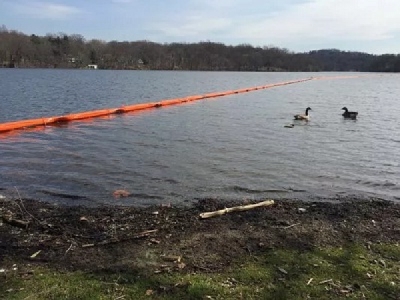
Posted on April 13, 2017
By James M. O'Neill, NorthJersey.com
Dredging will begin again soon in Pompton Lake in the most extensive phase of the three-year, $50 million cleanup of runoff from the nearby DuPont munitions plant, which left the lake polluted with mercury, lead and other contaminants.
A crane lifted metal framing into place on the shoreline at a staging area for the project recently while a small barge motored across the lake, as preparations continued for a summer of dredging.
The dredging is expected to begin later this month or early in May.
“We’re on schedule,” said Elias Rodriguez, a spokesman for the federal Environmental Protection Agency, which is overseeing the cleanup.
About 128,000 cubic yards of contaminated sediment will be dredged from a 36-acre portion of the lake bottom, near the mouth of Acid Brook, along Lakeside Avenue.
This second phase follows last year’s initial dredging, which removed nearly 29,000 cubic yards of sediment, or about 2,000 truckloads.
Last year’s dredging involved a large scoop on a floating barge working in a small area of the lake. This year’s dredging will be hydraulic and involves pumping the material through pipes to a staging area on shore, where water will be removed and treated before being pumped back into the lake. The sediment will then be trucked to a special landfill that handles contaminated material.
The cleanup is the responsibility of Chemours, a spinoff company of DuPont. Chemours hired Stevenson Environmental Services as the contractor for the cleanup.
“We had a very successful first season of lake cleanup, thanks to the hard work and close coordination of EPA, local officials, Chemours and the Pompton Lakes community,” Catherine McCabe, the EPA’s acting regional administrator, said in a statement. “EPA will continue to work with local authorities and the community to ensure that the cleanup is effective and continues to go smoothly.”
To prepare for this year’s dredging, workers have been installing utility lines to provide electricity to the staging area that will power the machinery to treat the sediment for disposal. Over the past month, they have also reconfigured an access roadway and the staging area to fit the hydraulic dredging machinery. The staging area on Lakeside Avenue is just east of Lakeside Middle School.
Workers are also installing a turbidity curtain around the area that will be dredged, to ensure that contaminated sediment suspended in the water from the dredging operation can’t float into the rest of the lake.
In addition, workers will remove fish from the work zone and relocate them to the part of the lake outside the turbidity curtain, said Dave Kluesner, an EPA spokesman. The fish can be captured in a number of ways, such as the use of netting or electric shock, he said.
The mercury, lead and other pollutants in the sediment and soil on the shoreline came from a munitions facility DuPont once had in Pompton Lakes and Wanaque. The pollution was carried to the lake by Acid Brook, which runs through the former industrial site. The DuPont facility operated from 1902 to 1994, making blasting caps, metal wires and aluminum and copper ammunition shells the United States used in the two world wars and other military conflicts.
The EPA wants the sediment removed because a toxic form of mercury can build up in fish, posing a health risk to humans who eat them. Exposure to mercury can damage nervous systems and harm the brain, heart, kidneys, lungs and immune system.
The 200-acre Pompton Lake is a backup source to replenish a key reservoir that supplies drinking water to towns in Bergen and Passaic counties. The lake is used by residents for skiing, boating and fishing, but it is so contaminated that fishermen are warned not to eat their catch.
Ultimately about 130,000 cubic yards of material will be removed. Some residents had lobbied the EPA to conduct a more extensive cleanup that included areas where lower levels of mercury were detected in the sediment, but officials decided against that.
Next year, in the project’s final phase, a layer of clean sandy fill will be spread over the 36-acre area of the lake still to be dredged, and the shoreline will be restored with native plants.
Source: NorthJersey.com





